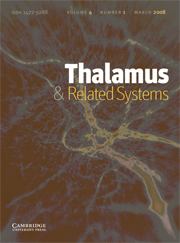Article contents
An in vivo intracellular study of auditory thalamic neurons
Published online by Cambridge University Press: 18 April 2006
Abstract
The intrinsic electrophysiological properties of medial geniculate body (MGB) neurons and their responses to noise bursts/pure tones were examined in the pentobarbital anesthetized guinea pig through intracellular recording. Discharge rate was calculated in the absence of acoustic stimuli over varied membrane potentials which were changed by intracellular injection of current or through automatic drifting. The non-acoustically-driven firing rate was 45.8 ± 23.3 Hz (mean ± S.D., n = 8) at membrane potentials of −45 mV, 30.6 ± 19.4 Hz (n = 14) at −50 mV, 18.0 ± 12.9 Hz (n = 14) at −55 mV, and significantly decreased to 5.7 ± 7.4 Hz at −60 mV, and to 0.7 ± 1.5 Hz (n = 10) at −65 mV (ANOVA, P < 0.001). The maximum non-acoustically-driven rate observed in the present study was 160 Hz. The auditory responsiveness of the MGB neurons was examined at membrane potentials over a range of −45 to −75 mV: the higher the membrane potential, the greater the responsiveness and vice versa. A putative non-low-threshold calcium spike (non-LTS) burst was observed in the present study. It showed significantly longer inter-spike intervals (11.6 ± 6.0 ms, P < 0.001, t-test) than those associated with the putative LTS bursts (6.7 ± 2.4 ms, P < 0.001, t-test). The dependence of the temporal structure of the spikes/spike bursts on the stimulus may provide insight into the temporal coding of sound information in the auditory system.
Keywords
Information
- Type
- Research Article
- Information
- Copyright
- Elsevier Science Ltd
- 1
- Cited by

